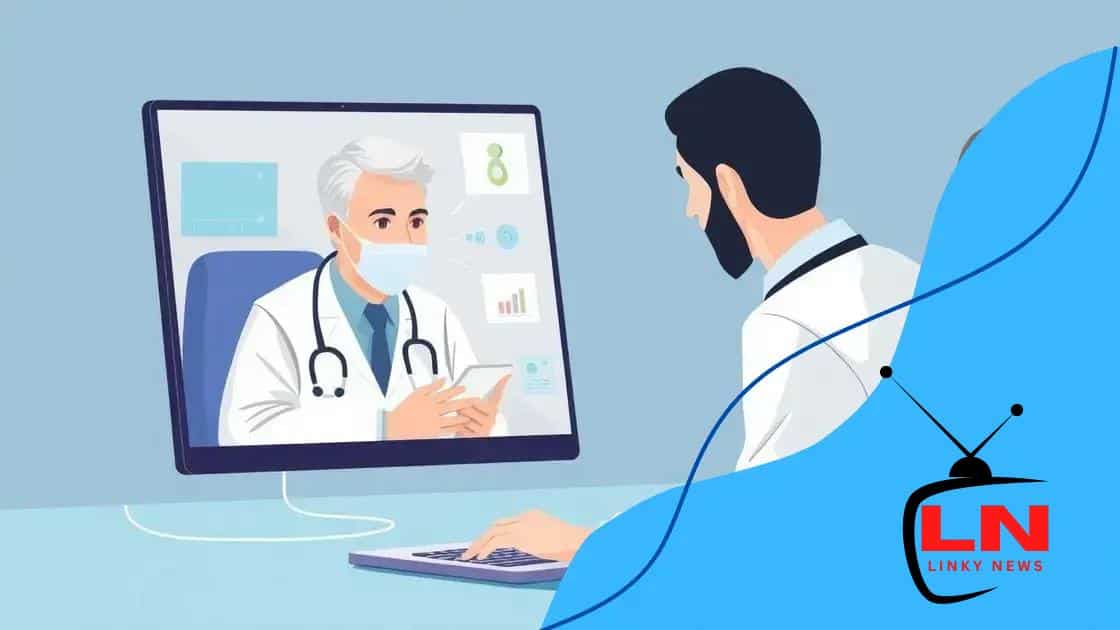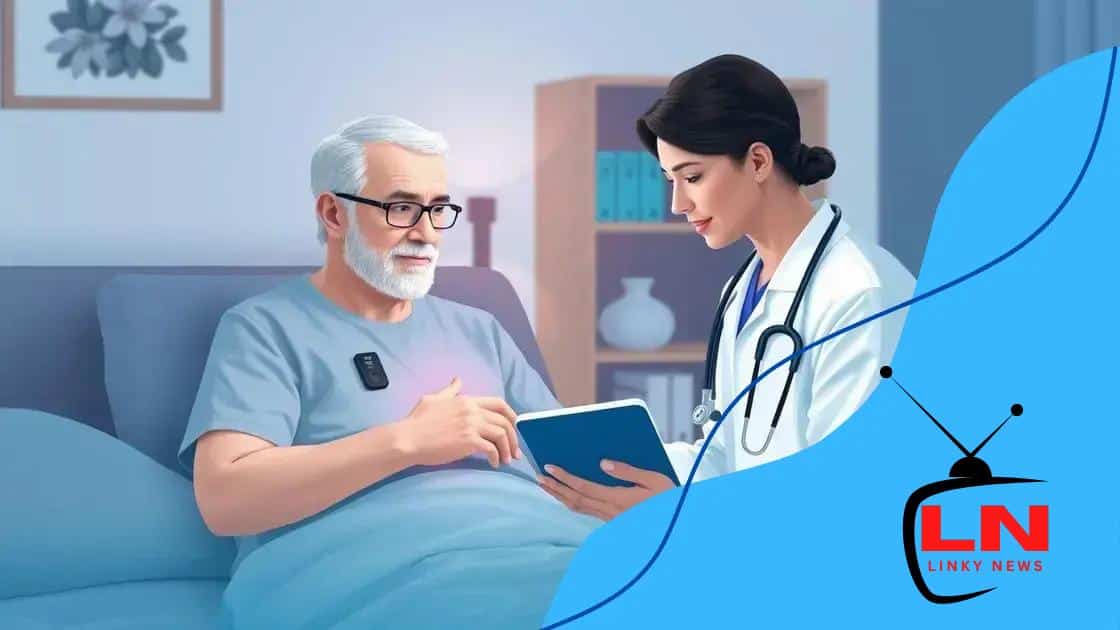5G boosting telemedicine services for better healthcare

5G technology is revolutionizing telemedicine by providing faster connectivity, enhancing remote patient monitoring, and enabling real-time data sharing, all while improving patient care and access to specialized services.
5G boosting telemedicine services is changing how we access healthcare. Imagine having a specialist just a click away, no matter where you are. Curious about how this technology reshapes medical services? Let’s dive in.
The role of 5G in enhancing telemedicine
The role of 5G in enhancing telemedicine is significant. With faster speeds and lower latency, healthcare providers can offer more effective remote services, transforming patient care.
Benefits of 5G in Telemedicine
One of the biggest advantages of 5G is its ability to support high-quality video calls. This improvement makes consultations more effective. Patients can receive real-time feedback and care.
- Improved video quality for virtual consultations.
- Faster data transfer for sharing medical images.
- Better connectivity in rural and underserved areas.
Additionally, 5G enables more devices to connect simultaneously. This means that multiple healthcare professionals can interact with a single patient, leading to comprehensive care. Imagine a scenario where a patient consults with a doctor, a nurse, and a specialist—all at the same time, no matter where they are located.
Real-Time Monitoring of Patients
Another key point is real-time monitoring. With 5G, wearable devices can transmit health data instantly. Doctors receive updates on patients’ conditions as they happen. This immediate access can be crucial for timely interventions and improving health outcomes.
As we explore further, the enhancement of telemedicine through 5G doesn’t just stop at virtual visits. It also expands the potential for remote surgeries and advanced diagnostics.
Overall, the integration of 5G into telemedicine is paving the way for a more connected and responsive healthcare environment, benefiting both patients and providers.
Benefits of fast connectivity for virtual consultations
Benefits of fast connectivity for virtual consultations are vast. With 5G, patients enjoy smoother video calls, leading to better communication with their doctors. High-speed connectivity reduces lag, which is crucial during medical discussions.
Enhancing Communication
Quality video and audio make communication clear. Doctors can assess patients more effectively, ensuring accurate diagnoses. Additionally, patients feel more engaged when they can see their healthcare providers clearly, fostering trust and satisfaction.
- Clear video leads to better assessments.
- Reduced lag time for real-time discussions.
- Improved overall patient experience.
Fast connectivity also supports the sharing of medical data instantaneously. When doctors need to discuss tests, they can send images or documents in real-time, removing the waiting game. This swift exchange of information enhances decision-making.
Access to Specialists
Another great advantage of fast connectivity is access to specialists. A patient in a remote area can have a consultation with an urban specialist without traveling. This opens up new avenues for receiving expert care.
Moreover, patients can connect with multiple specialists in one session, allowing for comprehensive care strategies. This seamless integration is a game changer, especially for complicated cases that require diverse opinions.
Overall, fast connectivity through 5G transforms the landscape of virtual health consultations, making healthcare more efficient and accessible.
How 5G improves remote patient monitoring

How 5G improves remote patient monitoring is a critical part of modern healthcare. With faster and more reliable connections, doctors can keep a close eye on patients from afar. This technology ensures that essential health data is sent instantly.
Instant Data Transmission
With 5G, devices can transmit patient data in real-time. This means heart rates, blood pressure, and other vital signs are monitored continuously. Immediate alerts can be set for any irregularities, allowing for quick responses.
- Real-time alerts for health changes.
- Frequent updates on patient conditions.
- Improved accuracy in health tracking.
Moreover, patients no longer have to visit clinics regularly for check-ups. They can wear advanced monitoring devices at home, ensuring convenience and comfort. For many, this reduces stress and enhances the quality of life.
Enhanced Collaboration Among Healthcare Providers
Another key benefit is the ability for multiple healthcare providers to access data simultaneously. With 5G, specialists can review a patient’s information in real-time during consultations. This capability leads to better-coordinated care plans.
As a result, doctors can collaborate more effectively, whether they’re in the same room or miles apart. The integration of 5G technology transforms remote monitoring into a vital and seamless part of healthcare management.
Challenges facing 5G implementation in healthcare
Challenges facing 5G implementation in healthcare are significant. While this technology offers great promise, various hurdles must be overcome to realize its full potential. Understanding these obstacles is crucial for successful integration.
Infrastructure Costs
One major challenge is the high cost of 5G infrastructure. Upgrading existing systems requires significant investment. Hospitals and clinics need funding for new equipment and software, which can strain budgets.
- Expensive installations of new antennas and base stations.
- Need for specialized training for healthcare staff.
- Ongoing maintenance costs for updated systems.
Moreover, not all areas have the same access to 5G networks. Rural healthcare facilities often lag behind urban counterparts due to limited infrastructure. This disparity can lead to unequal access to telemedicine services.
Data Security and Privacy
Another major concern is data security. With 5G, more devices will connect to the network, increasing the risk of cyber-attacks. Protecting patient information is vital. Any data breaches can have severe consequences for patient trust and institutional liability.
Healthcare providers must invest in robust cybersecurity measures. This includes encryption and regular audits to ensure compliance with health regulations.
Overall, while 5G holds the potential to revolutionize healthcare delivery, addressing these challenges is essential for safe and effective implementation. Stakeholders must work together to overcome these obstacles and ensure that advances benefit all patients.
Future trends of telemedicine with 5G technology
Future trends of telemedicine with 5G technology are exciting and promising. As healthcare continues to evolve, the potential of 5G will pave the way for innovative solutions. This technology is expected to enhance patient experiences and improve healthcare delivery.
Increased Use of Artificial Intelligence
One significant trend is the integration of artificial intelligence (AI) in telemedicine platforms. With the speed of 5G, AI can analyze patient data quickly. This leads to faster diagnoses and tailored treatment plans, boosting healthcare effectiveness.
- AI-powered chatbots for patient inquiries.
- Automated analysis of medical images.
- Predictive analytics for personalized care.
The higher bandwidth provided by 5G allows for the use of more complex AI applications, making telemedicine smarter and more efficient.
Expanded Virtual Reality Applications
Another exciting trend is the use of virtual reality (VR) in telemedicine. With 5G, healthcare providers can conduct virtual reality therapy sessions or simulate surgical procedures for training. This application can revolutionize how patients experience medical treatments.
Patients can engage in immersive therapy programs that help with conditions like anxiety or PTSD. The faster data speeds ensure seamless experiences for users, making virtual reality a practical tool in everyday healthcare.
Overall, the future trends of telemedicine are bright with 5G. As technology progresses, we can expect drastic changes that will enhance telehealth services, making them more accessible and effective.
FAQ – Frequently Asked Questions about 5G and Telemedicine
How will 5G improve telemedicine services?
5G will provide faster internet speeds, allowing for high-quality video consultations and real-time data sharing, improving overall patient care.
What are the main challenges of implementing 5G in healthcare?
Challenges include high infrastructure costs and concerns about data security and patient privacy.
What role does AI play in the future of telemedicine?
AI will enhance telemedicine by providing quick data analysis, automating processes, and personalizing patient care through predictive analytics.
How can remote patient monitoring benefit from 5G technology?
5G enables real-time monitoring of patients’ health data, allowing for quicker responses to health changes and reducing the need for frequent office visits.





